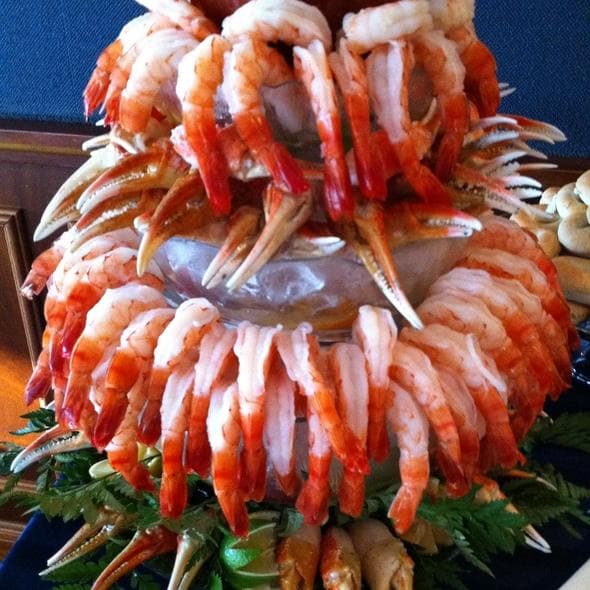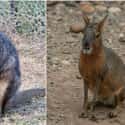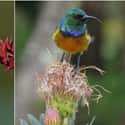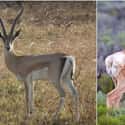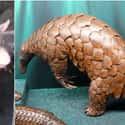-
(#5) Kangaroo And Cavy
Yes, the little fella on the left is a small species of kangaroo, which helps to better illustrate the point, but even big 'roos share similarities with cavies (also known as a dillaby or mara). The cavy is typically found in Argentina, while the kangaroo is, as everyone knows, synonymous with Australia. The Lincoln Park Zoo's page on cavies sums it up nicely. Like kangaroos, their "rear legs are long...They are brown with white undersides, with hindquarters marked with a white patch. A large snout and large eyes are prominent on the face." The kangaroo, however, is a marsupial, unlike the cavy.
-
(#10) Mole And Marsupial Mole
These two are similar to the flying squirrel and sugar glider: remarkably similar in many ways, but different in one huge way. The Australian marsupial mole, as the name indicates, is indeed a marsupial while the standard North American mole is placental (like humans). But both species, as PBS notes, "burrow through soft soil to find and eat insects" and have a "streamlined body shape" with "modified forelimbs for digging." Australia's status as an island for the last 100 million years or so has led to fascinating cases of convergent evolution like this.
-
(#3) Hummingbird And Sunbird
The familiar hummingbird on the left is a New World (Americas) bird, while the similar sunbird is from the Old World (Africa, Europe, and Asia). They belong to different orders but have similar lifestyles. Encyclopedia Britannica notes that they both "dart among tropical flowers, feeding upon nectar" and have a similar appearance because of how their feeding habits evolved (check out those bills). Some sunbirds also hover like hummingbirds when they feed. Their metabolic behavior is similar in certain species, too: both sunbirds and hummingbirds living at high altitudes have been known to enter a state of torpor at night, just like stoners in Denver.
-
(#4) Antelope And Pronghorn
These guys look remarkably similar, eh? On the left is an antelope (gazelle to be exact) and on the right is a pronghorn. Pronghorns are native to North America, while antelopes call Africa and Asia home. You know that classic American song "Home on the Range"? The one that goes, "Oh, give me a home where the buffalo roam/Where the deer and the antelope play"? There are no antelope in America. You've been lied to! Despite appearances to the contrary, the pronghorn's closest "relative" is actually the giraffe. They are, however, found in the same biomes as antelope, which likely led to their similar behavioral traits.
-
(#15) Giant Anteater And Spiny Anteater
These two anteaters don't look a whole lot alike, but they both behave in similar ways. They both have "a long, sticky tongue, few teeth, a rugged stomach, and large salivary glands" so they can live on a diet of ants. It's a very particular and kind of gross example of convergent evolution, but they did what they had to do, right? And they did it on entirely different continents: the giant anteater (on the left) is native to South America, while the spiny variety comes from Oceania.
-
(#14) Giant Armadillo And Giant Pangolin
These tank-like bad boys are not related but evolved similar characteristics. The giant armadillo is a native of North America, while the giant pangolin is from Africa. Both are mammals, and both evolved hard exteriors due to similar environmental conditions and evolutionary "pressure." The armadillo evolved a shell made from "plates of dermal bone" while the pangolin got keratin scales (similar in nature to horns).
New Random Displays Display All By Ranking
About This Tool
There are no genetically identical creatures, and even a random pair of identical twins will have subtle genetic differences. Due to individual differences, it is clear that the totally same species does not exist. But there are similar animal pairs with differences in the genetic structure, two different creatures that are geographically distant can converge and evolve to be very similar, such as the emerald tree boa and the Morelia Viridis.
There are more than 7 million species of animals living on the planet, sure that those species that look very similar are not surprised. The random tool lists 15 similar but unique animal pairs that are separated by a long distance.
Our data comes from Ranker, If you want to participate in the ranking of items displayed on this page, please click here.

